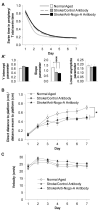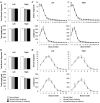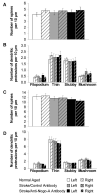Cognitive recovery in the aged rat after stroke and anti-Nogo-A immunotherapy
- PMID: 20035795
- PMCID: PMC2831114
- DOI: 10.1016/j.bbr.2009.12.015
Cognitive recovery in the aged rat after stroke and anti-Nogo-A immunotherapy
Abstract
We have previously shown that immunotherapy directed against the protein Nogo-A leads to recovery on a skilled forelimb reaching task in rats after sensorimotor cortex stroke, which correlated with axonal and dendritic plasticity. Here we investigated anti-Nogo-A immunotherapy as an intervention to improve performance on a spatial memory task in aged rats after stroke, and whether cognitive recovery was correlated with structural plasticity. Aged rats underwent a unilateral distal permanent middle cerebral artery occlusion and one week later were treated with an anti-Nogo-A or control antibody. Nine weeks post-stroke, treated rats and normal aged rats were tested on the Morris water maze task. Following testing rats were sacrificed and brains processed for the Golgi-Cox method. Hippocampal CA3 and CA1 pyramidal and dentate gyrus granule cells were examined for dendritic length and number of branch segments, and CA3 and CA1 pyramidal cells were examined for spine density and morphology. Anti-Nogo-A immunotherapy given one week following stroke in aged rats improved performance on the reference memory portion of the Morris water maze task. However, this improved performance was not correlated with structural changes in the hippocampal neurons examined. Our finding of improved performance on the Morris water maze in aged rats after stroke and treatment with anti-Nogo-A immunotherapy demonstrates the promising therapeutic potential for anti-Nogo-A immunotherapy to treat cognitive deficits after stroke. The identification of sites of axonal and dendritic plasticity in the aged brain after stroke and treatment with anti-Nogo-A immunotherapy is still under investigation.
Copyright 2010 Elsevier B.V. All rights reserved.
Figures







Similar articles
-
Delayed anti-nogo-a therapy improves function after chronic stroke in adult rats.Stroke. 2011 Jan;42(1):186-90. doi: 10.1161/STROKEAHA.110.590083. Epub 2010 Nov 18. Stroke. 2011. PMID: 21088244 Free PMC article.
-
Intrathecal treatment with anti-Nogo-A antibody improves functional recovery in adult rats after stroke.Exp Brain Res. 2007 Sep;182(2):261-6. doi: 10.1007/s00221-007-1067-0. Epub 2007 Aug 24. Exp Brain Res. 2007. PMID: 17717658
-
Delayed inhibition of Nogo-A does not alter injury-induced axonal sprouting but enhances recovery of cognitive function following experimental traumatic brain injury in rats.Neuroscience. 2005;134(3):1047-56. doi: 10.1016/j.neuroscience.2005.04.048. Neuroscience. 2005. PMID: 15979242
-
Therapeutics targeting Nogo-A hold promise for stroke restoration.CNS Neurol Disord Drug Targets. 2013 Mar;12(2):200-8. doi: 10.2174/1871527311312020006. CNS Neurol Disord Drug Targets. 2013. PMID: 23394537 Free PMC article. Review.
-
Neuronal plasticity and functional recovery after ischemic stroke.Top Stroke Rehabil. 2008 Jan-Feb;15(1):42-50. doi: 10.1310/tsr1501-42. Top Stroke Rehabil. 2008. PMID: 18250073 Review.
Cited by
-
Neurovascular remodeling in the aged ischemic brain.J Neural Transm (Vienna). 2015 Aug;122 Suppl 1:S25-33. doi: 10.1007/s00702-013-1148-0. Epub 2013 Dec 31. J Neural Transm (Vienna). 2015. PMID: 24378703 Review.
-
Improved Functional Outcome After Peripheral Nerve Stimulation of the Impaired Forelimb Post-stroke.Front Neurol. 2021 Apr 20;12:610434. doi: 10.3389/fneur.2021.610434. eCollection 2021. Front Neurol. 2021. PMID: 33959086 Free PMC article.
-
Constraint-induced movement therapy enhances angiogenesis and neurogenesis after cerebral ischemia/reperfusion.Neural Regen Res. 2019 Oct;14(10):1743-1754. doi: 10.4103/1673-5374.257528. Neural Regen Res. 2019. PMID: 31169192 Free PMC article.
-
Amantadine Alleviates Postoperative Cognitive Dysfunction Possibly by Preserving Neurotrophic Factor Expression and Dendritic Arborization in the Hippocampus of Old Rodents.Front Aging Neurosci. 2020 Nov 26;12:605330. doi: 10.3389/fnagi.2020.605330. eCollection 2020. Front Aging Neurosci. 2020. PMID: 33324197 Free PMC article.
-
Therapeutic Hypothermia Increases the Expression of RNA-binding Protein Motif 3 and Attenuates Cognitive Deficits Following Cardiac Arrest in Rats.Neurochem Res. 2025 Apr 3;50(2):134. doi: 10.1007/s11064-025-04383-1. Neurochem Res. 2025. PMID: 40257581 Free PMC article.
References
-
- Recommendations for Standards Regarding Preclinical Neuroprotective and Restorative Drug Development. Stroke. 1999;30:2752–2758. - PubMed
-
- Andersen MB, Zimmer J, Sams-Dodd F. Specific behavioral effects related to age and cerebral ischemia in rats. Pharmacol Biochem Behav. 1999;62:673–682. - PubMed
-
- Badan I, Buchhold B, Hamm A, Gratz M, Walker LC, Platt D, Kessler C, Popa-Wagner A. Accelerated glial reactivity to stroke in aged rats correlates with reduced functional recovery. J Cereb Blood Flow Metab. 2003;23:845–854. - PubMed
Publication types
MeSH terms
Substances
Grants and funding
LinkOut - more resources
Full Text Sources
Medical
Miscellaneous

